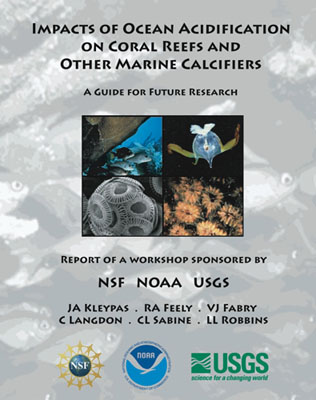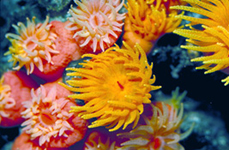|
New! |
(The following images contain links to more information):
|
 How is ocean acidity changing? How will ecosystems be affected?
What research is being done?
For the answers to these questions and more, click the image to the left to
go to the Ocean Acidification Network, an information network
for the internal scientific community.
How is ocean acidity changing? How will ecosystems be affected?
What research is being done?
For the answers to these questions and more, click the image to the left to
go to the Ocean Acidification Network, an information network
for the internal scientific community.
|
 Impacts of Ocean Acidification on Coral Reefs and Other Marine Calcifiers July 5, 2006:
Worldwide emissions of carbon dioxide from fossil fuel burning are dramatically altering ocean chemistry
and threatening marine organisms, including corals, that secrete skeletal structures and support
oceanic biodiversity. The report (accessed via the picture at left) released today summarizes the known
effects of increased atmospheric carbon dioxide on these organisms, known as marine calcifiers, and recommends
future research for determining the extent of the impacts.
Click the image to the left for the full report.
(9,677 KB PDF)
Impacts of Ocean Acidification on Coral Reefs and Other Marine Calcifiers July 5, 2006:
Worldwide emissions of carbon dioxide from fossil fuel burning are dramatically altering ocean chemistry
and threatening marine organisms, including corals, that secrete skeletal structures and support
oceanic biodiversity. The report (accessed via the picture at left) released today summarizes the known
effects of increased atmospheric carbon dioxide on these organisms, known as marine calcifiers, and recommends
future research for determining the extent of the impacts.
Click the image to the left for the full report.
(9,677 KB PDF)
|
 Carbon Dioxide and Our Ocean Legacy April 7, 2006:
Global climate change is increasing ocean temperatures
and raising sea levels. New scientific
research shows that our oceans are beginning
to face yet another threat due to global climate change -
their basic chemistry is
changing because of the uptake of carbon
dioxide released by human activities.
Click the image to the left for the full report.
(100KB PDF)
Carbon Dioxide and Our Ocean Legacy April 7, 2006:
Global climate change is increasing ocean temperatures
and raising sea levels. New scientific
research shows that our oceans are beginning
to face yet another threat due to global climate change -
their basic chemistry is
changing because of the uptake of carbon
dioxide released by human activities.
Click the image to the left for the full report.
(100KB PDF)
|
 The Dangers of Ocean Acidity:
Listen to RealAudio
Listen to MP3
The Dangers of Ocean Acidity:
Listen to RealAudio
Listen to MP3
April 6, 2006: Are humans changing the chemistry of the world's oceans by burning fossil fuels?
Is carbon dioxide a threat to coral reefs and marine ecosystems?
The problem starts with fuels like coal and gas that release carbon dioxide into the atmosphere.
The excess carbon dioxide contributes to global warming. But carbon dioxide is not just making things hotter.
It's also changing the chemistry of the world's oceans. Is the 'acidification' of seawater a threat to the
future of coral reefs and other living organisms?
|
 NOAA / NSF Cruise reveals impacts of ocean acidification on chemistry, biology of North Pacific Ocean
April 5, 2006: Data collected from ocean sampling in the Pacific Ocean from the southern to
northern hemispheres confirms that the oceans are becoming more acidic. A recently completed field
study from Tahiti to Alaska collecting data about the effects of ocean acidification on the water
chemistry and marine organisms found evidence that verifies earlier computer model projections. These
findings are consistent with data from previous field studies conducted in other oceans.
Click the image to the left for the full story.
NOAA / NSF Cruise reveals impacts of ocean acidification on chemistry, biology of North Pacific Ocean
April 5, 2006: Data collected from ocean sampling in the Pacific Ocean from the southern to
northern hemispheres confirms that the oceans are becoming more acidic. A recently completed field
study from Tahiti to Alaska collecting data about the effects of ocean acidification on the water
chemistry and marine organisms found evidence that verifies earlier computer model projections. These
findings are consistent with data from previous field studies conducted in other oceans.
Click the image to the left for the full story.
|
 Results from Workshop on the Impacts of Increasing Atmospheric CO2 on
Coral Reefs and Other Marine Calcifiers.
Calcification rates of several major groups of marine calcifying organisms, from both neritic and pelagic environments,
will very likely decrease in response to changes in ocean carbonate chemistry. Although benthic and planktonic calcifiers
of both neritic and pelagic communities display a similar response to increased CO2
forcing, important differences exist between the two that will dictate different approaches toward assessing
the larger potential effects of reduced calcification on ecosystem structure and function, how the effects could
cascade to other ecosystems, and ultimately, the changes in the ocean carbon cycle. Click on the image to the
left for results from the April 2005 Workshop in Florida.
Results from Workshop on the Impacts of Increasing Atmospheric CO2 on
Coral Reefs and Other Marine Calcifiers.
Calcification rates of several major groups of marine calcifying organisms, from both neritic and pelagic environments,
will very likely decrease in response to changes in ocean carbonate chemistry. Although benthic and planktonic calcifiers
of both neritic and pelagic communities display a similar response to increased CO2
forcing, important differences exist between the two that will dictate different approaches toward assessing
the larger potential effects of reduced calcification on ecosystem structure and function, how the effects could
cascade to other ecosystems, and ultimately, the changes in the ocean carbon cycle. Click on the image to the
left for results from the April 2005 Workshop in Florida.
|
 • Global Inventory Changes:
The PMEL CO2 Program helps monitor changes in ocean carbon
chemistry by making inorganic carbon measurements throughout the water column on research
cruises in the Atlantic, Pacific, and Indian oceans. This work is organized under the
US Clivar/CO2 Repeat Hydrography Program
and is coordinated with international partners through the IOCCP. Click on the image to the right for more
information on this Program.
• Global Inventory Changes:
The PMEL CO2 Program helps monitor changes in ocean carbon
chemistry by making inorganic carbon measurements throughout the water column on research
cruises in the Atlantic, Pacific, and Indian oceans. This work is organized under the
US Clivar/CO2 Repeat Hydrography Program
and is coordinated with international partners through the IOCCP. Click on the image to the right for more
information on this Program.
 How is ocean acidity changing? How will ecosystems be affected?
What research is being done?
For the answers to these questions and more, click the image to the left to
go to the Ocean Acidification Network, an information network
for the internal scientific community.
How is ocean acidity changing? How will ecosystems be affected?
What research is being done?
For the answers to these questions and more, click the image to the left to
go to the Ocean Acidification Network, an information network
for the internal scientific community.
 Impacts of Ocean Acidification on Coral Reefs and Other Marine Calcifiers July 5, 2006:
Worldwide emissions of carbon dioxide from fossil fuel burning are dramatically altering ocean chemistry
and threatening marine organisms, including corals, that secrete skeletal structures and support
oceanic biodiversity. The report (accessed via the picture at left) released today summarizes the known
effects of increased atmospheric carbon dioxide on these organisms, known as marine calcifiers, and recommends
future research for determining the extent of the impacts.
Click the image to the left for the full report.
(9,677 KB PDF)
Impacts of Ocean Acidification on Coral Reefs and Other Marine Calcifiers July 5, 2006:
Worldwide emissions of carbon dioxide from fossil fuel burning are dramatically altering ocean chemistry
and threatening marine organisms, including corals, that secrete skeletal structures and support
oceanic biodiversity. The report (accessed via the picture at left) released today summarizes the known
effects of increased atmospheric carbon dioxide on these organisms, known as marine calcifiers, and recommends
future research for determining the extent of the impacts.
Click the image to the left for the full report.
(9,677 KB PDF)
 Carbon Dioxide and Our Ocean Legacy April 7, 2006:
Global climate change is increasing ocean temperatures
and raising sea levels. New scientific
research shows that our oceans are beginning
to face yet another threat due to global climate change -
their basic chemistry is
changing because of the uptake of carbon
dioxide released by human activities.
Click the image to the left for the full report.
(100KB PDF)
Carbon Dioxide and Our Ocean Legacy April 7, 2006:
Global climate change is increasing ocean temperatures
and raising sea levels. New scientific
research shows that our oceans are beginning
to face yet another threat due to global climate change -
their basic chemistry is
changing because of the uptake of carbon
dioxide released by human activities.
Click the image to the left for the full report.
(100KB PDF)
 The Dangers of Ocean Acidity:
Listen to RealAudio
Listen to MP3
The Dangers of Ocean Acidity:
Listen to RealAudio
Listen to MP3
 NOAA / NSF Cruise reveals impacts of ocean acidification on chemistry, biology of North Pacific Ocean
April 5, 2006: Data collected from ocean sampling in the Pacific Ocean from the southern to
northern hemispheres confirms that the oceans are becoming more acidic. A recently completed field
study from Tahiti to Alaska collecting data about the effects of ocean acidification on the water
chemistry and marine organisms found evidence that verifies earlier computer model projections. These
findings are consistent with data from previous field studies conducted in other oceans.
Click the image to the left for the full story.
NOAA / NSF Cruise reveals impacts of ocean acidification on chemistry, biology of North Pacific Ocean
April 5, 2006: Data collected from ocean sampling in the Pacific Ocean from the southern to
northern hemispheres confirms that the oceans are becoming more acidic. A recently completed field
study from Tahiti to Alaska collecting data about the effects of ocean acidification on the water
chemistry and marine organisms found evidence that verifies earlier computer model projections. These
findings are consistent with data from previous field studies conducted in other oceans.
Click the image to the left for the full story.
 Results from Workshop on the Impacts of Increasing Atmospheric CO2 on
Coral Reefs and Other Marine Calcifiers.
Calcification rates of several major groups of marine calcifying organisms, from both neritic and pelagic environments,
will very likely decrease in response to changes in ocean carbonate chemistry. Although benthic and planktonic calcifiers
of both neritic and pelagic communities display a similar response to increased CO2
forcing, important differences exist between the two that will dictate different approaches toward assessing
the larger potential effects of reduced calcification on ecosystem structure and function, how the effects could
cascade to other ecosystems, and ultimately, the changes in the ocean carbon cycle. Click on the image to the
left for results from the April 2005 Workshop in Florida.
Results from Workshop on the Impacts of Increasing Atmospheric CO2 on
Coral Reefs and Other Marine Calcifiers.
Calcification rates of several major groups of marine calcifying organisms, from both neritic and pelagic environments,
will very likely decrease in response to changes in ocean carbonate chemistry. Although benthic and planktonic calcifiers
of both neritic and pelagic communities display a similar response to increased CO2
forcing, important differences exist between the two that will dictate different approaches toward assessing
the larger potential effects of reduced calcification on ecosystem structure and function, how the effects could
cascade to other ecosystems, and ultimately, the changes in the ocean carbon cycle. Click on the image to the
left for results from the April 2005 Workshop in Florida.



